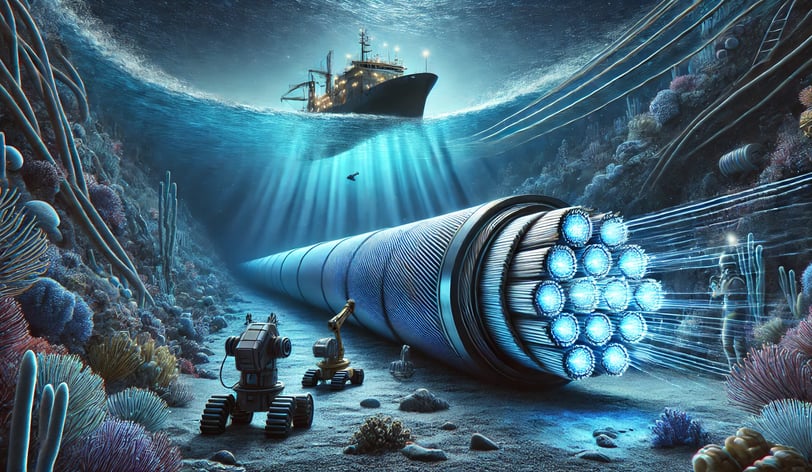Submarine Cables: The Hidden Infrastructure of the Global Internet
The global connectivity of the internet relies on an infrastructure that is mostly invisible but essential: submarine fiber optic cables. These cables span thousands of kilometers beneath the oceans, connecting continents and enabling data transmission at impressive speeds. Despite advancements in wireless and satellite technologies, these cables remain the backbone of the internet, carrying more than 95% of global data traffic.
3/6/20252 min read


Structure and Functioning
Submarine cables are composed of multiple protective layers, including polymers, steel, and copper, to withstand oceanic pressure, corrosion, and mechanical impacts. At the core, there are extremely thin optical fibers responsible for transmitting data in the form of light pulses. These pulses are amplified by repeaters installed along the cable’s length, ensuring signal continuity over long distances.
The installation of these cables is carried out by specialized ships, which carefully lay the structure along the ocean floor. The route is planned to avoid geological faults and minimize risks, ensuring the infrastructure’s maximum durability.
What Is Transmitted?
Submarine cables carry nearly all essential digital information required for the modern world’s functioning. This includes:
Real-time communication (calls, video conferences, messages);
International financial transactions;
Website hosting and cloud services;
Video streaming and online gaming;
Scientific data and government information.
Without this infrastructure, the internet as we know it would not exist, becoming extremely slow and limited in capacity.
Benefits of Submarine Cables
The existence of submarine cables provides several advantages for global connectivity:
Speed and Low Latency – Compared to satellite communication, submarine cables offer faster and more stable connections, ensuring better performance for real-time services.
Transmission Capacity – Submarine cables support massive volumes of data simultaneously, which is crucial for the growing demand of the internet.
Cost-Effectiveness – Despite the high initial investment, maintaining and operating submarine cables is cheaper in the long run compared to alternative solutions such as satellite networks.
Global Connectivity – They enable countries and continents to exchange information without relying solely on local or terrestrial infrastructures.
Risks and Challenges
Although highly efficient, submarine cables face some challenges and threats:
Physical Damage – Human activities, such as trawling and ship anchors, can sever cables. Additionally, natural phenomena such as undersea earthquakes pose considerable risks.
Cyberattacks and Espionage – Since cables carry critical data, there are concerns about interception attempts by governments or malicious groups.
Maintenance and Repairs – When a cable is damaged, repairs can take weeks and require specialized vessels to locate and fix the break.
Dependency and Vulnerability – Some countries rely heavily on just a few cables, making their communications susceptible to disruptions in case of failures.
The Future of Submarine Connectivity
Despite these challenges, the demand for submarine cables continues to grow. Technology and telecommunications companies invest billions in expanding this infrastructure to support the increasing data traffic. Innovative projects are under development, including cables with higher capacity, enhanced durability, and redundancy to minimize disruptions.
There is also a trend toward greater diversification in cable distribution, reducing dependence on specific routes and mitigating risks associated with isolated failures.
Conclusion
Submarine cables are the backbone of global connectivity, ensuring that billions of people and businesses worldwide can access information, communicate, and conduct business daily. Although largely unseen, their importance is undeniable, and their evolution will continue to shape the future of the internet and global telecommunications.
Explore
Discover diverse topics in one convenient hub.
Connect
Learn
contact@mindstormblog.com
© 2025. All rights reserved.


